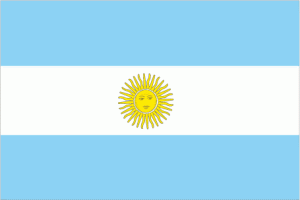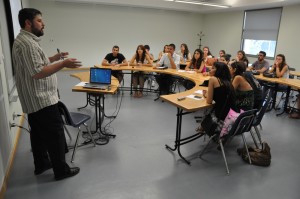 Population of Argentina 2014
Population of Argentina 2014
Based on the total number of births, total number of deaths, net migration rate, and the population of 2013, the current population of the Argentine Republic is estimated to be 41,899,801, which makes up about 0.58% of the total world population. Argentina is ranked 32nd in the world population rankings, behind Kenya, but ahead of Algeria. On July 1, 2013, the population was recorded as 41,446,246. Thus, since last July, the population has grown by about 453,555 or by a growth rate of 1.09%. The 2010 World Population Prospects reported that the population was 40,412,000. Thus, since 2010, the population has grown by 1,487,801 people or by a growth rate of 3.68%. The population in 2000 was estimated to be about 36,931,000. Thus, since 2000, the population has grown by 4,968,801 people or by a growth rate of 13.45%. Based on the total land area and the total population of the country, the population density of Argentina is about 15.3 people per square kilometer or 39.65 people per square mile.
Government of Argentina 2014
The Constitution of Argentina is the guiding legal document and framework for Argentina’s government. The country is considered a federal constitutional republic and a representative democracy. The government is made up of three branches that engage in checks and balances: executive, legislative, and judicial. The executive branch consists of the president and his or her cabinet. The president is the commander-in-chief and has the ability to veto laws passed by the legislative branch. Since December of 2007, the president has been Cristina Kirchner, and as of December of 2013, the Chief of the Cabinet of Ministers has been Jorge Capitanich. The legislative branch, known as the National Congress, is a bicameral legislation, made up of the Senate and the Chamber of Deputies. The President of the Senate is also the Vice-President, who is currently Amado Boudou, and Julian Dominguez currently presides over the Chamber of Deputies. The Senate has 72 seats and the Chamber of Deputies has 257 seats. The judicial branch is made up of numerous federal judges and a Supreme Court. The President of Argentina appoints all nine members of the Supreme Court. The current President of the Supreme Court is Dr. Ricardo Lorenzetti. Lastly, there is universal suffrage in Argentina that allows for secret and equal voting in the elections for the government officials, but it is also mandatory for all citizens to vote.
Geography of Argentina 2014
The total land area of Argentina is 2,780,400 square kilometers or 1,073,518 square miles. The maximum distance from north to south is 3,694 kilometers or 2,295 miles and the maximum distance from east to west is 1,423 kilometers or 884 miles. The country borders five countries, which include Chile to the west, Bolivia and Paraguay to the north, Brazil to the northeast, and Uruguay to the east. The highest point in the country is also the highest point in the Southern and Western Hemispheres. Mount Aconcagua, which is in the Mendoza province, reaches 6,959 meters or 22,831 feet above sea level. The lowest point in the country is also the lowest point in the Southern and Western Hemispheres. Laguna del Carbon in the Santa Cruz province reaches -105 meters or -344 feet below sea level. Lastly, the Parana and Uruguay rivers join together to form the Rio de la Plata, which helps form the border between Argentina and Uruguay.
Language in Argentina 2014
The national language of Argentina is Spanish, otherwise known as Castilian in Hispanophone countries. The most frequent dialect of Castilian is Rioplatense, whose speakers are mainly located in the Rio de la Plata basin. Besides Spanish, the most widely spoken language is English. 42.3% of Argentineans claim to speak some English. However, only about 15.4% of those that claim to speak some English actually have a high level of English comprehension. But, English is taught in the schools since elementary school. Another prominent language throughout Argentina is the Brazilian dialect of Portuguese. There are also decent sized populations that speak Italian, a dialect of Arabic, and Standard German. Lastly, due to the large number of indigenous communities, there also exist a large number of indigenous languages spoken throughout the country. For example, Guarani and Quechua are two indigenous languages spoken in their respective regions.
 Education in Argentina 2014
Education in Argentina 2014
According to UNICEF, in 2012, the total adult literacy rate was 97.9% of the population. However, the youth literacy rate of males is 99% and the youth literacy rate of females is 99.4%. Thus, the younger population is receiving better education than the older generation, which signals an advance in society for the upcoming generation. 98.9% of males participate and attend primary schools, while 99.1% of females participate and attend the primary schools. Then, about 87.5% of males participate in secondary school, while 90.6% of females participate in secondary school. Argentina has a mandatory school system from ages 5 to 17. The first three years of secondary school are considered compulsory, but the last two to three years are not required. After secondary school, students have an option to attend a university. In fact, there are currently 39 national universities, financed by the Ministry of Finance. However, if students wish to pursue a different career track, there is a strong network of vocational schools where students can study a specific trade.
Health and Health Care in Argentina 2014
The health care system in Argentina is made up of three different proponents: private, public, and social. The private sector covers approximately 5% of the population. It is similar to the private health care in the United States, where individuals will pay their insurance companies and receive benefits based on their specific plans. The public sector covers about 50% of the population and is financed through the taxes. Health care is considered to be a universal human right in Argentina. Thus, regardless of income, nationality, or legal status, any person in Argentina has the right to use the health care facilities. However, over the past few years, the number of immigrants has increased, along with the number of unemployed. Thus, the public sector of the health care system is very crowded, resulting in waiting periods for health care. The public health care facilities also suffer from a lack of supplies. The increase in the usage of the public system has not been met with a proper increase in spending for necessary supplies or for updates in the technology. Instead, the government has decided to focus on spending more on drugs and pharmaceuticals. The social sector is known as the Obras Sociales. Every person that is considered to have formal employment must pay into this type of health care. The Obras Sociales is run by the trade unions for each sector. The employers and employees each pay a fixed rate for health insurance, which then subsidizes the actual health care costs of the employee. As of 2011, 5.3% of Argentina’s GDP was spent on health care.
As of 2012, the life expectancy of someone born in Argentina is 76.1 years. The under-five mortality rate was 14 deaths per 1,000 children under five years. The infant mortality rate is 13 infant deaths per 1,000 births. About 7.2% of children are born with low birth weight. As of 2011, 99.2% of the population uses improved drinking water sources and 96.3% of the population uses improved sanitation facilities. Lastly, only 0.4% of the population has been diagnosed with HIV in Argentina.
Argentina Profile
Argentina Population Projections
Based on the current birth, death, and migration rates of the Argentine Republic, the population is expected to increase to approximately 42.08 million people by the year 2015, which is an increase of about 1%. Then, by the year 2020, the population is expected to reach 43.69 million people, an increase of approximately 4.9% from the current population. Continuing this trend, the population will reach 45.17 million by the year 2025, increasing by 8.4% from the current population of the country. By 2030, the population will hit 46.48 million, increasing by about 11.6% from the current population. Then, by 2035, the population will increase by 14.3% and by over 1 million people up to about 47.618 million people. Also, by 2040, the population will increase to about 48.59 million people, an increase of about 16.6%. Lastly, by the mid-century mark, the population will top 50 million, reaching a population of about 50.003 million people, which will be an increase of about 20%.
Argentina Demographics
Argentina, similar to the United States, is considered to be a country of many immigrants. In fact, about 86% of the population claims to be of European descent. Then, an approximate 8% of the population is considered to be Mestizo, which is a person of mixed descent of European and American Indian. Also, an approximate 4% is of Arab or Middle Eastern descent. The last 2% is of miscellaneous races from around the globe.
Religion in Argentina
The Argentine Republic guarantees the freedom of religion constitutionally, but the government has to support the Roman Catholic Church economically. In fact, about 92% of the country identify as Christian (70%-90% out of that 92% is Roman Catholic). About 3% of the population identifies as agnostic, while 1% identify as atheists. About 2% of the population is Muslim, while only 1% of the population is Jewish. However, Argentina is considered to have the largest Jewish population of any other Latin American country. Also, the Protestant religion is the religion whose followers regularly attend the church services.
Sports in Argentina
Argentina’s national sport since 1953 is pato, which is a game played on the back of a horse with a six-handle ball. It is supposed to be a combination of polo and basketball. While pato is the national sport of the country, the most popular sport is football (or American soccer). The Argentina national team has won 25 major international championships. In fact, the Argentine Football Association (AFA) contains 3,377 football clubs. The second most popular sport is basketball; in fact, the national team is ranked first by the International Basketball Federation.
Argentinean Food
As is noted by the high percentage of Europeans in the country, there is a high cultural influence by Europe. The same goes for the food and cuisine throughout the country. The Argentine Republic consumes the second most amount of beef in the entire world due to its extreme popularity throughout the country. The cattle are fed with only grass and raised on an open range. Not only is beef a very important part of the country, but the country is also the fifth most important producer of wine in the entire world. The province of Mendoza actually accounts for 70% of the total production of wine in Argentina.